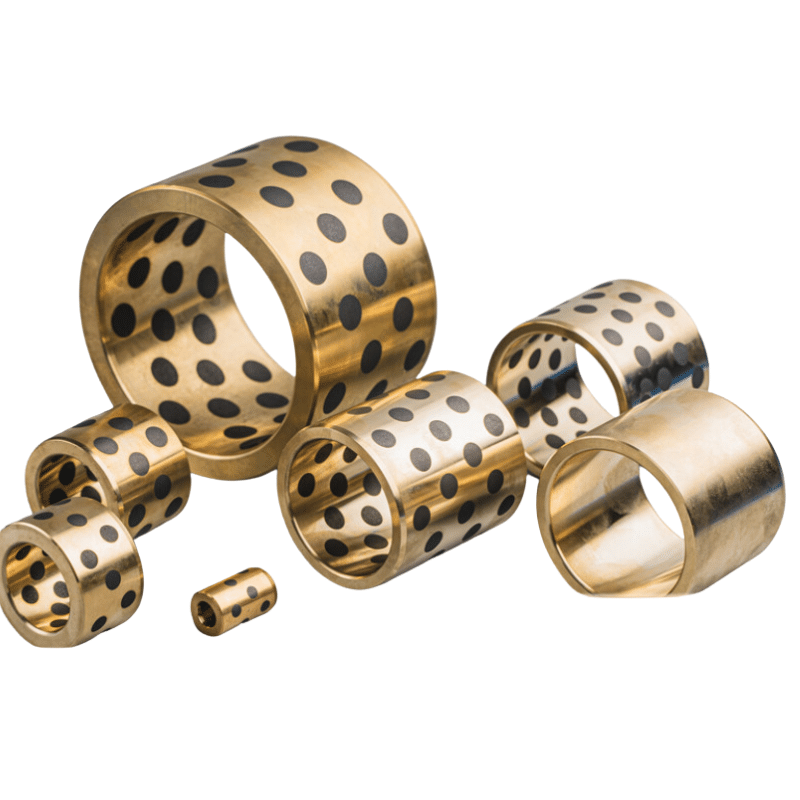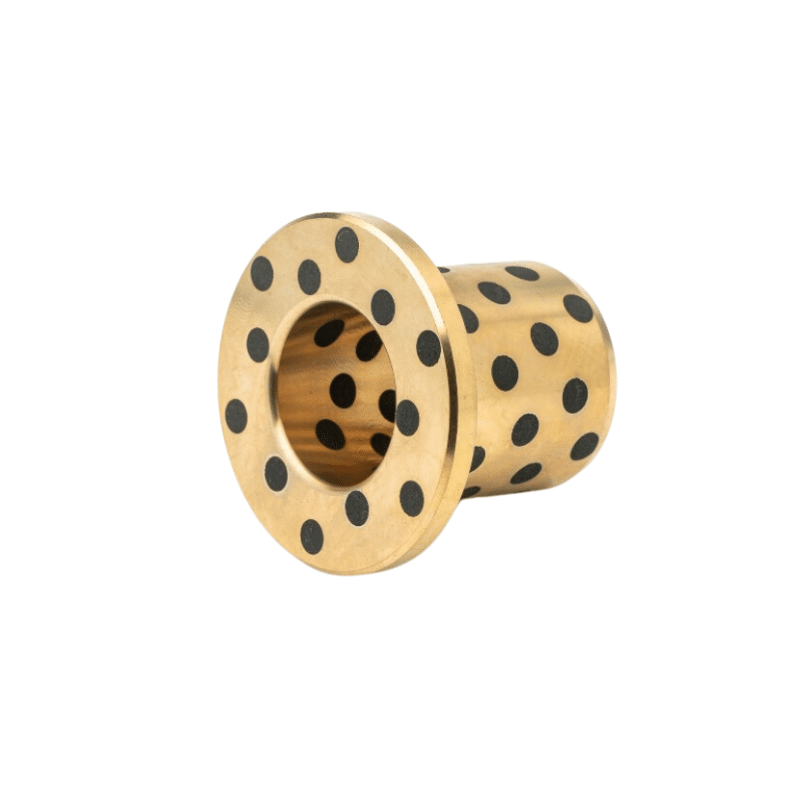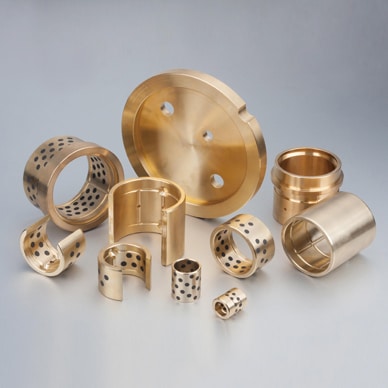Bronze Bush Bearing
Bronze Bush Bearing
Say goodbye to the hassle of frequent lubrication maintenance. Our self-lubricating technology ensures smooth operation and reduces wear and tear, extending the lifespan of your equipment. Experience uninterrupted productivity and cost savings as you bid farewell to the need for messy lubricants and time-consuming upkeep.
Manufacturing on Demand
Bronze Bush Bearing
Solid Bronze Bush Bearings: Optimal Performance in Harsh Environments
Solid bronze bearings are exceptionally adaptable and ideal for challenging situations, thriving in severe and contaminated conditions. Available in a variety of metric sizes, these bearings are offered in both straight and flanged versions. Crafted from durable material, they are particularly effective in scenarios involving oscillating movements at low rotational speeds.
These bronze bushings can be lubricated with either oil or grease, which enhances their sliding capabilities, minimizes wear, and provides corrosion protection. Bearings with a bore diameter of over 14 mm are designed with an axial lubrication groove on their sliding surface to ensure optimal lubrication. Every surface of these bushings is precisely machined to ensure peak performance.
we supply solid bronze bearings and flanged bushings, most of which are available for immediate global delivery. Customers can specify dimensions for customized production and rapid delivery. The website also features a downloadable datasheet that offers comprehensive product details.
In summary, solid bronze bearings are exceptionally robust and reliable, making them a top choice for a broad range of industrial applications, especially in environments where durability, corrosion resistance, and self-lubrication are crucial.
Solid Bronze Bush Bearings: straight & flanged bronze bushings, Custom Bronze Bush Bearing
Material and Performance: Solid bronze bush bearings are traditional and robust materials known for their excellent sliding properties, impact resistance, and ability to handle low-speed vibrations. These characteristics make them highly suitable for a wide range of applications. One of their main advantages is their tolerance to dirty environments, allowing them to operate effectively even when the quality of the shaft surface is suboptimal. A distinctive feature of these bearings is their capacity to retain lubricants, typically achieved through the incorporation of lubrication grooves.
Lubrication Groove Options: For all bush bearings with internal diameters greater than 14 millimeters, axial lubrication grooves are provided. This design helps to keep the lubricant within the bearing, enhancing both performance and lifespan. The placement of these grooves can vary depending on the operating conditions of the bearing. For instance, in rotational movements, the grooves might be placed at 60-degree intervals, whereas for oscillating movements, a 15-degree placement might be more suitable.
Materials Used in Solid Bronze Bush Bearings: The solid bronze material used in these bearings, such as in the bronze bush bearing, is typically a multi-component bronze like CuSn7Zn4Pb7, known for its superior sliding properties. This material is ideal for demanding applications in harsh environments. The manufacturing of these bushings is done with high precision to ensure that all surfaces are processed for optimal performance.
Lubrication: Solid bronze bush bearings can be lubricated with either oil or grease. Lubricants not only improve sliding performance but also reduce wear and prevent corrosion. While oils can be used in special circumstances, grease lubrication is more common. It is advisable to use seals in highly contaminated environments to protect both the bushing and the lubricant.
In conclusion, for applications requiring durable, low-maintenance bearing solutions, solid bronze bush bearings are a reliable choice. The design and placement of lubrication grooves play a crucial role in ensuring that the bearings remain adequately lubricated under various operating conditions.
Detailed Description of Materials for Solid Bronze Bush Bearings
Solid bronze bearings are primarily made from CuSn7Zn4Pb7, a continuously cast bronze alloy. This material is predominantly copper, making up 85% of the alloy composition, and is renowned for its excellent sliding properties due to its specific metal content. The manufacturing process ensures that all surfaces of these bearings are precisely machined to achieve optimal performance.
Beyond the standard CuSn7Zn4Pb7 alloy, several other bronze alloys are commonly used for different applications. These include:
- CuAl10Ni: This alloy is known for its high resistance to corrosion and erosion, making it suitable for maritime and industrial applications.
- CuSn10: A tin bronze that is highly wear-resistant, often used in heavy-load applications.
- CuSn12: Known for its outstanding wear resistance and mechanical properties under severe loading conditions.
Lubrication of Solid Bronze Bush Bearings, Custom plain bearings
Typically, solid bronze bearings are lubricated using grease. However, oil can also be used, particularly in exceptional applications where specific performance characteristics are required. The choice of a high-quality lubricant is critical as it forms a protective film between the bearing and the shaft, significantly reducing friction and wear.
For environments where the bearings are exposed to high levels of contamination, it is recommended to seal the bearings. This sealing not only protects the bearing itself but also preserves the integrity of the lubricant used.
Furthermore, all solid bronze bearings that have an inside diameter of 14 mm or larger are equipped with an axial lubrication groove. This groove enhances the distribution of lubricant within the bearing, ensuring consistent lubrication during operation.
bronze bush Bearing, Lubrication Groove Options
Solid bronze bearings can be customized with different lubrication groove designs to suit various operational needs. These options facilitate the efficient management of lubricants, enhancing the bearing’s performance and longevity under different rotational speeds and load conditions.
Specification overview of solid bronze bushing bearings
| Specification overview | |
|---|---|
| Properties | solid bronze bush bearing Cusn7zn4pb7 |
| Max. load (Dyn/stat), N/mm2 | 25 / 45 |
| Max. sliding speed m/s | 0.5 |
| Max. PV value N/mm2 x m/s | 2.8 |
| Temperature range, oC | +250 (depending on the type of lubricant) |
| Shaft tolerance | e7 – e8 |
| Housing tolerance | H7 |
| Shaft roughness | Ra ≤ 1.0 |
| Shaft hardness | > 165 HB |
The design of lubrication holes and grooves is crucial for the lubrication of sliding bronze bush bearings, as they ensure that the lubricant can smoothly and effectively reach the bearing’s friction surfaces. Here are several key factors to consider when designing lubrication holes and grooves:
Size: The dimensions of the lubrication holes and grooves should be determined based on the size of the bronze bush bearing and its lubrication needs. Holes and grooves that are too large or too small may affect lubrication effectiveness.
Shape: The shape of the oil grooves should facilitate the distribution of lubricant. Common shapes include straight grooves, spiral grooves, and labyrinth grooves, each with specific application scenarios and advantages.
Position: The placement of lubrication holes and grooves should be carefully chosen to ensure that lubricant covers the bronze bush bearing’s critical friction areas.
Quantity: Depending on the working conditions of the bronze bush bearing and lubrication requirements, multiple lubrication holes and grooves may be necessary to ensure adequate lubrication.
Flow Direction: The design of the oil grooves should consider the flow direction of the lubricant to ensure even distribution throughout the bearing.
Marking: Lubrication holes and grooves should be clearly marked to aid maintenance personnel in identifying them and performing correct lubrication procedures.
Application: The specific application environment of the bronze bush bearing, such as temperature, load, and speed, should be considered in the design, as these factors can influence the design of lubrication holes and grooves.
Standards Compliance: Designs should adhere to relevant industrial standards, such as GB/T 35087-2018, to ensure that the dimensions, shapes, and markings of the lubrication holes and grooves meet industry norms.
Maintenance and Replacement: The design should also consider the ease of maintaining and replacing the lubricant to facilitate regular checks and replacement, maintaining the bronze bush bearing’s optimal performance.
By thoroughly considering these factors, lubrication holes and grooves can be designed to meet lubrication needs while also being maintenance-friendly, thereby enhancing the performance and lifespan of sliding bronze bush bearings.
Your expert in self-lubricating Bearing
and Bronze alloys – serving globally




